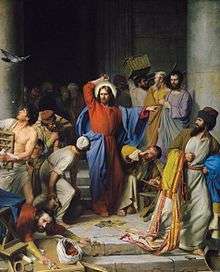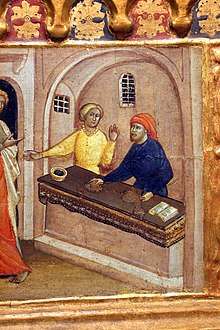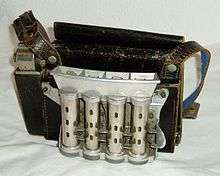Money changer
A money changer is a person or organization whose business is the exchange of coins or currency of one country, for that of another.[1] This trade was a predecessor of modern banking.[2]
The advent of paper money in the mid-17th century and the development of modern banking and floating exchange rates in the 20th century allowed a foreign exchange market to develop. This provided a way for banks and other specialist financial companies such as bureaux de change and forex brokers to easily change one country's money for another, and with the added confidence of transparency.
The 20th century also saw the development of machines that would change money, such as coin dispensers and change machines.
History


In ancient times in Jerusalem, pilgrims visiting the Jewish Temple on Jewish Holy Days would change some of their money from the standard Greek and Roman currency for Jewish and Tyrian money, the latter two the only ones accepted as payments inside the Temple.[3][4] With this Temple money the pilgrim would purchase a sacrificial animal, usually a pigeon or a lamb, in preparation for the following day's events.
During the Middle Ages in Europe, many cities and towns issued their own coins, often carrying the face of a ruler, such as the regional baron or bishop. When outsiders, especially traveling merchants, visited towns for a market fair, it became necessary to exchange foreign coins to local ones at local money changers. Money changers would assess a foreign coin for its type, wear and tear, and validity, then accept it as deposit, recording its value in local currency. The merchant could then withdraw the money in local currency to conduct trade or, more likely, keep it deposited: the money changer would act as a clearing facility.
As the size and operations of money changers grew they began to provide a lending facility, by adding the lending-fee to the foreign exchange rates. Later the Knights Templar provided this service to pilgrims traveling to and from the Holy Land.[5][6]
Mechanical device

A money changer (or coin changer or coin dispenser) is a device that changes or dispenses coins. It can take various forms. One type is a portable coin dispenser, invented by Jacques L. Galef, often worn on a belt, used by conductors and other professions for manual fare collection. It dispenses a single coin when a lever is depressed.
Another type is a fixed coin dispenser that dispenses several coins at once, such as four quarters or five nickels, for making change at a venue for coin-operated devices, such as a penny arcade, pinball parlor, or Automat. It is typically mounted in a manned booth or counter.
A third type, sometimes called a "change maker" or "Automatic Cashier", has an array of 100 or more buttons that dispense exact amounts of change from 1¢ to $1.00. These are typically found at teller windows in banks and sometimes in retail establishments. This type of change maker may also operate electromechanically under control of a cash register, automatically giving correct change for a customer's purchase.
See also
- Bank of Amsterdam
- Central bank
References
| Wikimedia Commons has media related to Money changers. |
| Wikivoyage has a travel guide for Money & currency exchange. |
- "Dictionary and Thesaurus | Merriam-Webster". www.merriam-webster.com. Archived from the original on 2017-12-23. Retrieved 2016-03-19.
- Raymond De Roover (2008). Money, Banking and Credit in Mediaeval Bruges - Italian Merchant Bankers, Lombards and Money Changers - A Study in the Origins of Banking. Read Books. p. 464. ISBN 978-1-4437-2609-2.
- Sanders, E. P. The historical figure of Jesus. Penguin, 1993.
- Ehrman, Bart D.. Jesus, Interrupted, HarperCollins, 2009. ISBN 0-06-117393-2
- Martin, Sean (2005). The Knights Templar: The History & Myths of the Legendary Military Order. p. 47, New York: Thunder's Mouth Press. ISBN 1-56025-645-1.
- Nicholson, Helen (2001). The Knights Templar: A New History. p. 4, Stroud: Sutton. ISBN 0-7509-2517-5.
